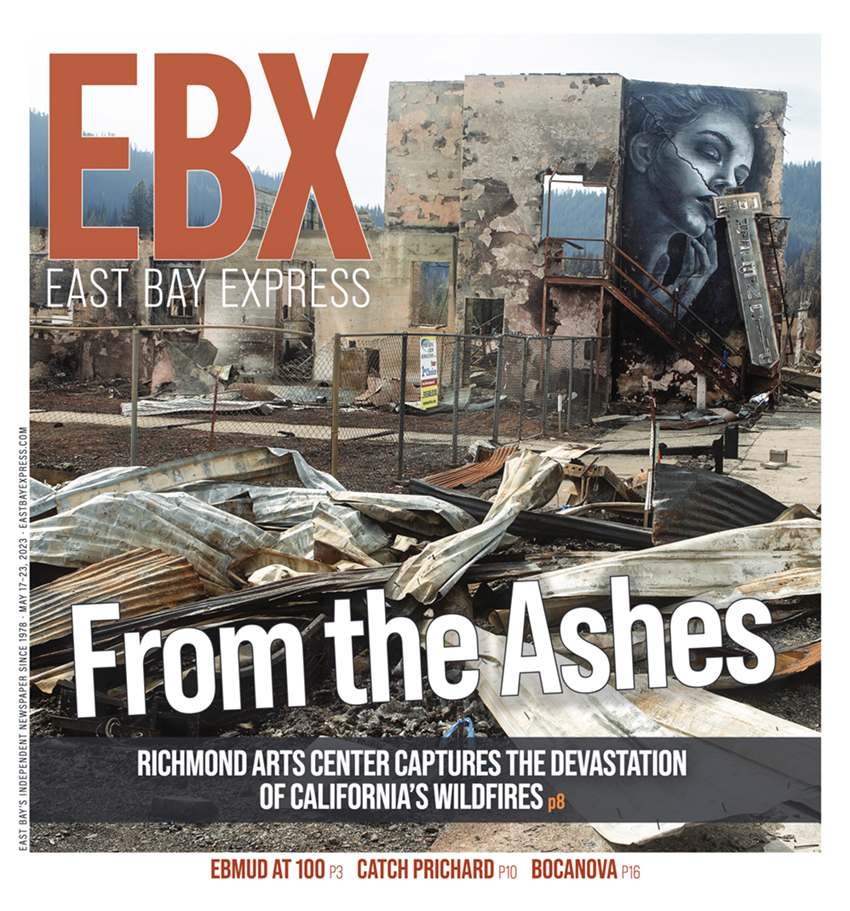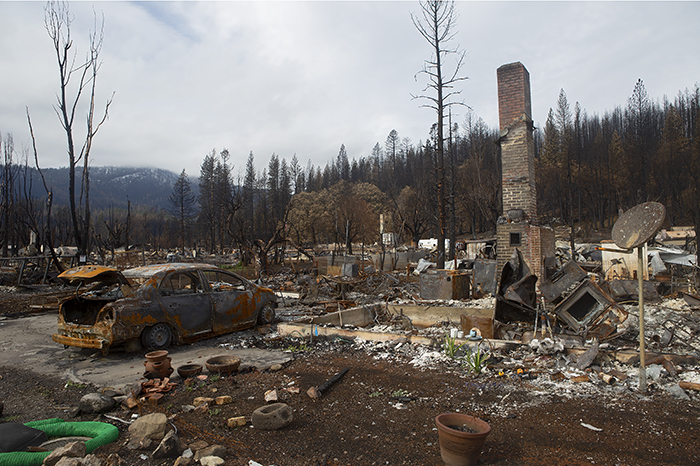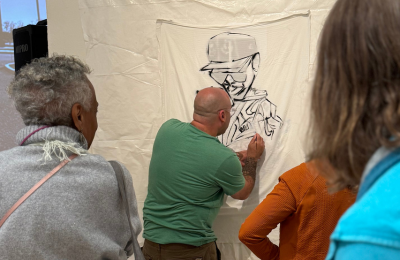East Bay Express: From the Ashes

East Bay Express
From the Ashes: Richmond Art enter Captures the Devastation of California’s Wildfires
Article weblink: https://eastbayexpress.com/through-the-fire/
Digital copy of the East Bay Express: https://edition.pagesuite-professional.co.uk/html5/reader/production/default.aspx?pubname=&pubid=8808aae8-e6fe-4270-adb0-c95bab71909c
Through the Fire
By Lou Fancher | May 17, 2023
Ruth Morgan’s stark and provocative works at Richmond Art Center highlight climate change’s role in CA wildfires
If artist Ruth Morgan’s 10 large-scale photographs currently on display at Richmond Art Center don’t send one’s ticker beating double time or one’s blood boiling, they must go immediately to the ER. They might be in cardiac arrest or have a circulatory system out of whack.
“Requiem: The Remains of the Day, August 4, 2021,” is part of RAC’s Spring Season themed environmental justice exhibits. Along with the community-based participatory art project “Fencelines” that addresses environmental issues specific to Richmond, Morgan’s “Requiem” introduces the impact of climate change and the uptick of massive, monumental wildfires in greater California.
The full color photographs—nine 40 x 60 inch images and one entry image 56 x 84 inches—document the aftermath of what happened during the summer of 2021 in Greenville. In a mere 45 minutes, the town was completely destroyed by the Dixie Wildfire. The photographs, taken months later and presented in Morgan’s signature large scale format, are not only sizable, but they are in their details compelling, devastating and profoundly moving without being in any way strident.
In the stark perspectives and landscapes rendered in full color rather than her signature black-and-white style, Morgan avoids melodrama but manages to create an intensely dramatic vibe that is dignified, respectful, egalitarian, even elegant. Unexpectedly, there is a haunting, eery and quiet beauty to the portrayals. The charred buildings, streets, homesteads and public spaces are entirely devoid of people but resonate with the full tragedy of human lives that have been cast into disarray and a community devastated by wildfire.
As a model of visual storytelling and proof of the impact of climate change on real people with real lives, the images themselves hold ironic magnetism. Striking a viewer as a kind of propellant, something visceral, with power equivalent to a wildfire, the accumulative effect instead might spur a person into action that goes far beyond passive observational or unexpressed empathy.
Importantly, the facts are these: In less than an hour, the Dixie Fire reduced 100 family homes, a gas station, church, hotel, museum, bar, schools, restaurants and other commercial business to rubble. Over 1,000 residents were displaced; many of them low income, marginalized people whose small homes were likely valued at $30,000 or less.

These were not the CEOs of Silicon Valley with multimillion dollar homes and fire insurance to cover any damages and rebuilding costs. Most Greenville residents lost everything they owned, including generations of family photographs and heirlooms. Fortunately, everyone was able to evacuate and no lives were sacrificed.
Morgan is widely known in the Bay Area as the founder/director in 1997 of Community Works West, an organization that works directly with people impacted by incarceration and uses art to address issues related to social justice to bring healing and restoration to marginalized communities. She recently retired from her leadership role at Community Works West, but her interest in the stories of underserved people who exist on the margins of mainstream society is lifelong and continues to be expressed through her body of work as a photographer.
Her acclaimed, award-winning photo series, publications and exhibits include “San Francisco County Jail #3,” “San Quentin: Maximum Security, 1981-83,” “Ohlone Elders and Youth Speak,” ”Piqua Shawnee: Cultural Survival in Their Homeland” and others.
Morgan’s photographs are in private collections and exhibited in museums including the San Francisco Museum of Modern Art, Houston and San Diego museums, the Matrix Gallery and the University Art Museum Berkeley. Most recently, her “S.F. Jail” archive was purchased by the San Francisco Public Library, and her “Ohlone Elders and Youth” archive was purchased by the Bancroft Library.
Exhibit notes for “Requiem” explain the Dixie Fire was later determined to have been caused by Pacific Gas and Electric Company equipment failure. Even so, human actions and inactions exacerbated and fed the fire’s intensity. Overgrown forests resulting from short-sighted, man-made fire suppression policies and housing development located near forests created an incendiary situation.
With climate change causing years of drought and more virulent storms during California’s increasingly extended wildfire season, there was high propensity for the volatile terrain to ignite. It was only a matter of time—and remains so—before a town like Greenville would suffer a blow.
Morgan said in an interview she had originally gone to the area intending to gather interviews from people who had been displaced. Upon her arrival, she found Greenville was like a ghost town. “Originally, the idea was to photograph the people impacted by climate change and the fire. To photograph the people most invisible. But there was no one there, other than a few people living in RVs outside of the area. The first two trips, I saw no one. The third time, I saw occasional people bulldozing, trying to clear the land. Eventually, it was totally razed and the rubble taken away. Now, it’s being reborn with people trying to rebuild,” she noted.
Although there are no physical people in the photographs, signs of human life are everywhere. In charred, residential areas, burned-out vehicles in driveways and crumbled chimneys in yards stand like ominous sentinels or gravestones where once an entire house stood. Personal items are visible—a typewriter, a bicycle, pots and pans, broken dishes, gardening pots and tools, children’s toys, a child’s desk. In one image, “#107” on a sign is the only thing that marks a family plot. In another, a street lamp having lost its verticality to the intense heat folds upon itself and curves downward, as if bowing like a supple, graceful ballet dancer.
Compellingly, black-and-white murals painted by Mendocino-based artist Shane Grammer on several burned and fragmented walls after the fire bring humanity back into the picture. One, painted on an exterior wall of a former movie theater, is of a glamorous film star-like woman, against which leans a detached, upside-down neon sign that reads, “Pioneer.” In another photograph, the image of Jesus adorns a chimney.
“Grammer came before I was there and on his own came and I assume wanted to make something of beauty in the space,” said Morgan. “Those murals were mesmerizing, and seen in the midst of the devastation, it was breathtaking. It was incongruous. It added to the mystery of everything that happened in Greenville.”
Aside from her reaction to the murals, Morgan said her initial and overall response to what she saw in Greenville was devastating, overwhelming. “Because of that, I became interested in photographing landscapes instead of people, which had not been my experience before,” she explained. “Initially, it was the enormity of the tragedy that struck me. To get there, you cross over mountains and drive into this valley. There, you come upon eight-square miles of total rubble. These were the homes of people who, many of them, had probably lived there for generations. I found solace only in connecting to the people through the remnants left.
“It was three to four months after the fire, so people had already come back and retrieved anything that meant something to them, anything that was still intact. But what remained still told a story. Remember, these lives weren’t shattered by an Act of God. It was human impact on climate change. Yes, a fire might have happened naturally, but that was not what happened here,” she continued.
Morgan said what happened in Greenville was such a monumental event that the exhibit needed large-scale imagery to capture the impact of the fire on the town. “If I could have, I would have had them all seven-feet wide, or larger. The large scale gives you a way to enter the work, and it’s powerful to be as close to the scene as you can. You have to see the details and those, you can only see in a larger format,” explained Morgan.
Working with RAC exhibitions director Roberto Martinez to curate the show, the two made the decision not to include in the exhibit the black-and-white photographs versions of the images Morgan has also printed and plans to exhibit in smaller venues. Morgan said those photographs are much smaller and have a different aura. “It felt like the 10 four-color photographs were enough to tell the story. I tend to think less is more,” she said.
Martinez has a masters in museum studies from JFK University and has worked with community-centered institutions like the Museum of Social Justice, the East Side Arts Alliance and LA Plaza de Cultura y Artes. He first met Morgan through Robbin Légère Henderson, a Berkeley-based artist, curator and writer who will be in conversation with Morgan at the gallery on May 27.
“I knew that during the spring I wanted to focus on the impact of the climate crisis. I felt Ruth’s work resonated with that. She has a wonderful eye and in the past has captured so much of humanity with her photographs from San Quentin or with the Ohlone community here in the Bay Area. This series was a striking contrast because there were no people in these photographs,” he noted.
Martinez said the human impact that fuels the climate crisis is huge and wants the images to wrap the viewer in a haunting embrace, but in a space that also feels safe. The exhibit design is intentionally quiet: The photographs have little additional interpretive content or labeling. “People can be there contemplating the images and not being told what to think,” he said. “They confront the images that are themselves quiet, despite the destruction you can see. There’s a somber tone to any place after a devastating force passes through it.”
One image that struck him deeply upon first seeing it shows a broad landscape of mountains and trees in the background. “You see that, and then in the foreground, you see a massive tangle of destruction. Then you see one of Shane’s murals, painted after the fire. In the mural, you see hope in humanity and how it might re-flourish,” he said.
The photograph with the collapsed streetlight, according to Martinez, also immediately grabbed him. He called it a powerful symbol suggestive of the connections that human actions have on the environments in which people live. Streetlights illuminate and increase community safety; wildfires also illuminate, but human carelessness can unleash flames strong enough to bend metal, destroy man-made inventions and diminish safety.
Martinez has definite ideas of the dialogue and action he hopes the exhibits will initiate. “Art opens doors and windows into difficult conversations. The mirror on harsh realities shown through art allows for transformations in our minds towards actions,” he said. “In Ruth’s exhibit, we see the devastating impact of climate change and a world devoid of humans in which we’ve destroyed ourselves. She’s helping us see the future in a foreboding sense, but it forces us to reckon with the possibilities.”
But seen in their totality, Martinez suggested the exhibits this season invite a participatory response that might result in hopeful solutions to alleviate the crisis. “I want to paint a picture that can be dark because it is, but a picture that motivates people to take actions to not walk toward that dark future, but to a different one. We want to plant, nurture and grow ideas around environmental justice,” he explained.
Morgan agreed and said the response she has received to the exhibit thus far has confirmed her overall purpose, which is to better understand what happened in Greenville and to cause people to become involved in protecting and preserving the natural environment.
“People are moved and sobered by ‘Requiem.’ For me, I am compelled to do this work, whether it’s to expose the criminal justice system or climate change. Greenville sounded an alarm for me and hopefully will for other people. We need to meet this moment. Individually and collectively, we can make a difference. We need to understand how much damage humans are having on the planet. We need to know we can still change course,” she said.
Asked for her thoughts about the power of imagery to convey complex matters relating to social or environmental justice, Morgan said, “For some people, the visual is more impactful than any words I can use. You can look at the photographs and see climate damage right there, unmistakably. As a photographer, I think there’s nothing like an image. One image can say a lot. The power of art is palpable.”
Tags: featured




